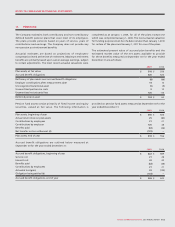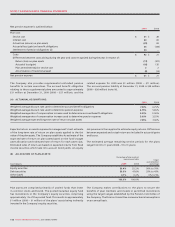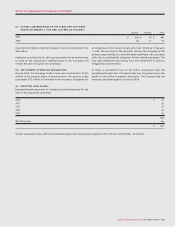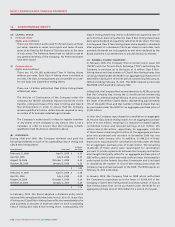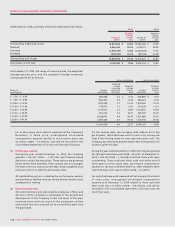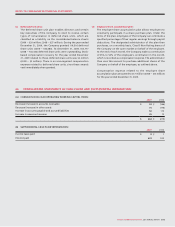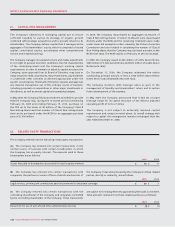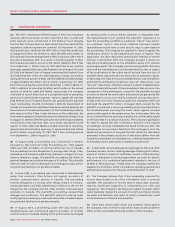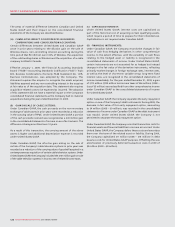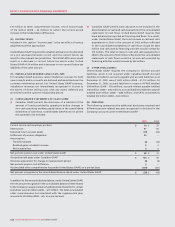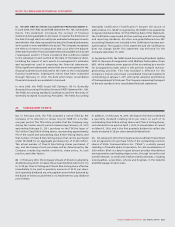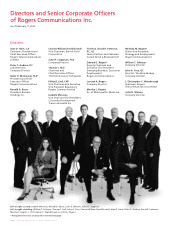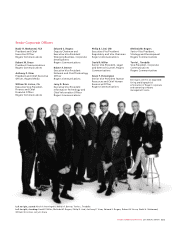Rogers 2009 Annual Report Download - page 118
Download and view the complete annual report
Please find page 118 of the 2009 Rogers annual report below. You can navigate through the pages in the report by either clicking on the pages listed below, or by using the keyword search tool below to find specific information within the annual report.
122 ROGERS COMMUNICATIONS INC. 2009 ANNUAL REPORT
NOTES TO CONSOLIDATED FINANCIAL STATEMENTS
(A) The CRTC collects two different types of fees from broadcast
licensees which are known as Part I and Part II fees. In 2003 and
2004, lawsuits were commenced in the Federal Court alleging
that the Part II licence fees are taxes rather than fees and that the
regulations authorizing them are unlawful. On December 14, 2006,
the Federal Court ruled that the CRTC did not have the jurisdiction
to charge Part II fees. On October 15, 2007, the CRTC sent a letter to
all broadcast licensees stating that the CRTC would not collect Part II
fees due in November 2007. As a result, in the third quarter of 2007,
the Company reversed its accrual of $18 million related to Part II fees
from September 1, 2006 to June 30, 2007. Both the Crown and the
applicants appealed this case to the Federal Court of Appeal. On April
28, 2008, the Federal Court of Appeal overturned the Federal Court
and ruled that Part II fees are valid regulatory charges. As a result,
during the second quarter of 2008, Cable and Media recorded charges
of approximately $30 million and $7 million, respectively, for CRTC
Part II fees covering the period from September 1, 2006 to March 31,
2008. In addition to recording $5 million and $2 million in the second
quarter of 2008 for Cable and Media, respectively, the Company
continued to record these fees on a prospective basis in operating,
general and administrative expenses. Leave to appeal the April 28,
2008 Federal Court of Appeal decision was granted by the Supreme
Court on December 18, 2008. On October 7, 2009, the Government of
Canada announced that a settlement had been reached between the
Government of Canada and members of the broadcasting industry
with respect to Part II fees. Under the terms of the settlement, the
Government agreed to forgive the amounts otherwise owing to it up
to August 31, 2009 and the fees going forward will be approximately
one-third less than historical rates. As a result, during the fourth
quarter of 2009, Cable and Media recorded recoveries in operating,
general and administrative expenses of approximately $60 million
and $19 million, respectively, for CRTC Part II fees covering periods
from September 1, 2006 to August 31, 2009.
(B) In August 2008, a proceeding was commenced in Ontario
pursuant to that province’s Class Proceedings Act, 1992 against
Cable and other providers of communications services in Canada.
The proceedings involve allegations of, among other things, false,
misleading and deceptive advertising relating to charges for long-
distance telephone usage. The plaintiffs are seeking $20 million in
general damages and punitive damages of $5 million. The plaintiffs
intend to seek an order certifying the proceedings as a class action.
Any potential liability is not yet determinable.
(C) In June 2008, a proceeding was commenced in Saskatchewan
under that province’s Class Actions Act against providers of
wireless communications services in Canada. The proceeding
involves allegations of, among other things, breach of contract,
misrepresentation and false advertising in relation to the 911 fee
charged by the Company and the other wireless communication
providers in Canada. The plaintiffs are seeking unquantified
damages and restitution. The plaintiffs intend to seek an order
certifying the proceeding as a national class action in Saskatchewan.
Any potential liability is not yet determinable.
(D) In August 2004, a proceeding under the Class Actions Act
(Saskatchewan) was commenced against providers of wireless
communications in Canada relating to the system access fee charged
by wireless carriers to some of their customers. In September 2007,
the Saskatchewan Court granted the plaintiffs’ application to
have the proceeding certified as a national, “opt-in” class action.
As a national, “opt-in” class action, affected customers outside
Saskatchewan would have to take specific steps to participate in
the proceeding. The Company has applied for leave to appeal the
certification decision to the Saskatchewan Court of Appeal. That
application was later adjourned pending the hearing of certain
motions. In December 2007, the Company brought a motion to
stay the proceeding based on the arbitration clause in its wireless
service agreements. The Company’s motion was granted in February
2008, and the Saskatchewan Court directed that its order in respect
of the certification of the action would exclude from the class of
plaintiffs those customers who are bound by an arbitration clause.
In April 2008, the Class Actions Act (Saskatchewan) was amended to
authorize the certification of national, “opt-out” class actions. In an
“opt-out” class action, affected customers outside of Saskatchewan
would automatically be part of the proceeding in that province. As a
consequence of the amendment, counsel for the plaintiffs brought
a motion to amend the certification order previously granted by the
Saskatchewan Court so as to certify a national, opt-out class action.
In May 2009, the Court refused to grant the requested relief and
dismissed the plaintiffs’ motion. In August 2009, counsel for the
plaintiffs commenced a second proceeding under the Class Actions
Act (Saskatchewan) asserting the same claims against wireless
carriers with respect to the system access fee. In December 2009, the
Court ordered that the second proceeding be conditionally stayed
on the basis that it is an abuse of process. The Company’s application
for leave to appeal the 2007 certification decision in the original
proceeding is currently scheduled to be heard in February 2010. The
Company has not recorded a liability for this contingency since the
likelihood and amount of any potential loss cannot be reasonably
estimated. If the ultimate resolution of this action differs from the
Company’s assessment and assumptions, a material adjustment to
its financial position and results of operations could result.
(E) In April 2004, a proceeding was brought against Fido and other
Canadian wireless carriers claiming damages totalling $160 million,
breach of contract, breach of confidence, breach of fiduciary duty
and, as an alternative to the damages claims, an order for specific
performance of a conditional agreement relating to the use of
38 MHz of MCS Spectrum. In May 2009, the Company settled this
litigation for $4 million, which is included in operating, general and
administrative expenses for the year ended December 31, 2009.
(F) The Company believes that it has adequately provided for
income taxes based on all of the information that is currently
available. The calculation of income taxes in many cases, however,
requires significant judgment in interpreting tax rules and
regulations. The Company’s tax filings are subject to audits, which
could materially change the amount of current and future income
tax assets and liabilities, and could, in certain circumstances, result
in the assessment of interest and penalties.
(G) There exist certain other claims and potential claims against
the Company, none of which is expected to have a material adverse
effect on the consolidated financial position of the Company.
24. CONTINGENT LIABILITIES:



